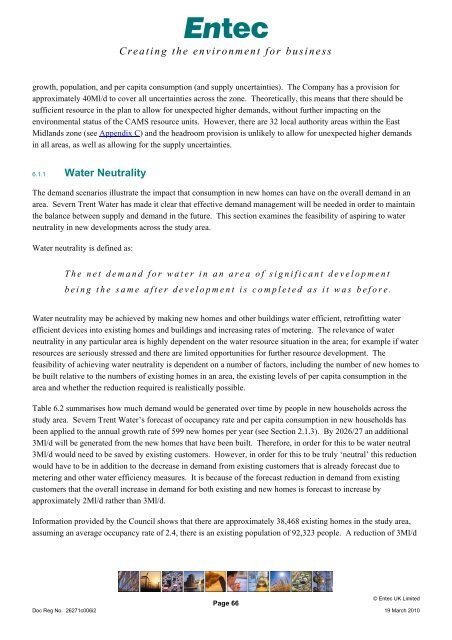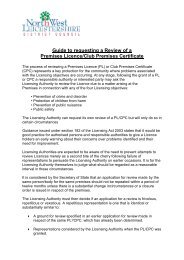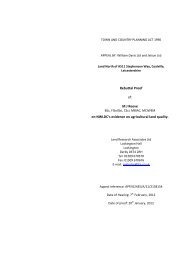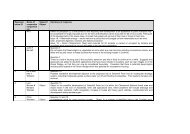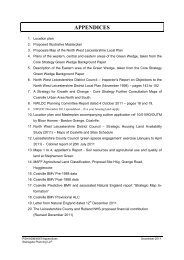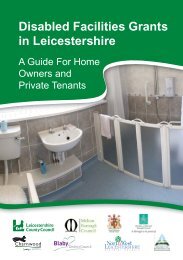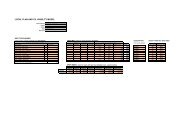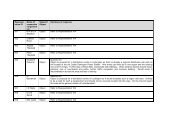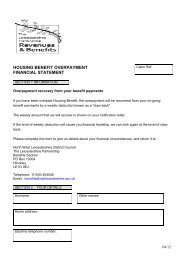Water Cycle Study - March 2010 - North West Leicestershire District ...
Water Cycle Study - March 2010 - North West Leicestershire District ...
Water Cycle Study - March 2010 - North West Leicestershire District ...
Create successful ePaper yourself
Turn your PDF publications into a flip-book with our unique Google optimized e-Paper software.
Creating the environment for business<br />
growth, population, and per capita consumption (and supply uncertainties). The Company has a provision for<br />
approximately 40Ml/d to cover all uncertainties across the zone. Theoretically, this means that there should be<br />
sufficient resource in the plan to allow for unexpected higher demands, without further impacting on the<br />
environmental status of the CAMS resource units. However, there are 32 local authority areas within the East<br />
Midlands zone (see Appendix C) and the headroom provision is unlikely to allow for unexpected higher demands<br />
in all areas, as well as allowing for the supply uncertainties.<br />
6.1.1 <strong>Water</strong> Neutrality<br />
The demand scenarios illustrate the impact that consumption in new homes can have on the overall demand in an<br />
area. Severn Trent <strong>Water</strong> has made it clear that effective demand management will be needed in order to maintain<br />
the balance between supply and demand in the future. This section examines the feasibility of aspiring to water<br />
neutrality in new developments across the study area.<br />
<strong>Water</strong> neutrality is defined as:<br />
The net demand for water in an area of significant development<br />
being the same after development is completed as it was before.<br />
<strong>Water</strong> neutrality may be achieved by making new homes and other buildings water efficient, retrofitting water<br />
efficient devices into existing homes and buildings and increasing rates of metering. The relevance of water<br />
neutrality in any particular area is highly dependent on the water resource situation in the area; for example if water<br />
resources are seriously stressed and there are limited opportunities for further resource development. The<br />
feasibility of achieving water neutrality is dependent on a number of factors, including the number of new homes to<br />
be built relative to the numbers of existing homes in an area, the existing levels of per capita consumption in the<br />
area and whether the reduction required is realistically possible.<br />
Table 6.2 summarises how much demand would be generated over time by people in new households across the<br />
study area. Severn Trent <strong>Water</strong>’s forecast of occupancy rate and per capita consumption in new households has<br />
been applied to the annual growth rate of 599 new homes per year (see Section 2.1.3). By 2026/27 an additional<br />
3Ml/d will be generated from the new homes that have been built. Therefore, in order for this to be water neutral<br />
3Ml/d would need to be saved by existing customers. However, in order for this to be truly ‘neutral’ this reduction<br />
would have to be in addition to the decrease in demand from existing customers that is already forecast due to<br />
metering and other water efficiency measures. It is because of the forecast reduction in demand from existing<br />
customers that the overall increase in demand for both existing and new homes is forecast to increase by<br />
approximately 2Ml/d rather than 3Ml/d.<br />
Information provided by the Council shows that there are approximately 38,468 existing homes in the study area,<br />
assuming an average occupancy rate of 2.4, there is an existing population of 92,323 people. A reduction of 3Ml/d<br />
Doc Reg No. 26271c006i2<br />
Page 66<br />
© Entec UK Limited<br />
19 <strong>March</strong> <strong>2010</strong>


